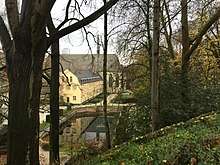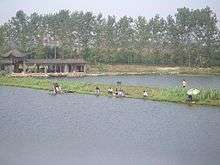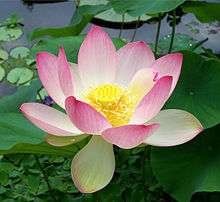Fish pond

A fish pond, or fishpond, is a controlled pond, artificial lake, or reservoir that is stocked with fish and is used in aquaculture for fish farming, or is used for recreational fishing or for ornamental purposes. In the medieval European era it was typical for monasteries and castles (small, partly self-sufficient communities) to have a fish pond.
History

Records of fish ponds being used can be found from the early period of the middle ages. "The idealized eighth-century estate of Charlemagne's capitulary de villis was to have artificial fishponds but two hundred years later, facilities for raising fish remained very rare, even on monastic estates.".[1] As the middle ages progressed, fish ponds became a more common feature of urbanizing environments.[1] This meant the people who had access to these fish ponds were able to access a food supply in a controlled environment not unlike pastures for cattle and sheep. However fish ponds were a difficult environment to maintain. They were a marker of power and authority, since only rich nobles and institutions such as monastery's could afford to maintain them.[1] During the winter, supplying fresh food for a castle garrison was a constant struggle. Nobles had access to meat from deer parks, but this didn't supply the needs of whole households. Though fish ponds required maintenance by the community to keep them healthy,[1] they were an elegant way of giving monasteries and noble houses access to fresh fish. Some of the more popular species of fish farmed in fish ponds were carp and pike. From the 14th century onward these fish proved to be a popular feature of artificial fish ponds.[1]
Aquaculture
Fish ponds have been used in aquaculture. They are/were common in:
- Canada
- Europe, especially in the Czech Republic (Rožmberk Pond, Velké Dářko, Lake Mácha), where common carp may be kept.
- Hawaii, U.S.A., , where the Native Hawaiians used them extensively.
- The Philippines where milkfish, tilapia, crabs, lobsters, tiger shrimp, snails and others may be kept.
- East Asia, especially in Japan with koi, trout, and white crucian carp.
Fish ponds are also being promoted in developing countries. They provide a source of food and income from the sale of fish for small farmers and can also supply irrigation needs and water for livestock.[2]
Gallery
 Classic fishing pond used by the Clay Cross Angling Club
Classic fishing pond used by the Clay Cross Angling Club Fishing pond on Grainthorpe Fen
Fishing pond on Grainthorpe Fen Coarse fishing pond in England
Coarse fishing pond in England Medieval fish pond
Medieval fish pond Historic fish pond
Historic fish pond Fishing platform, designed for wheelchair users, at the edge of a fish pond.
Fishing platform, designed for wheelchair users, at the edge of a fish pond.
See also
| Wikimedia Commons has media related to Fish ponds. |
Notes
- 1 2 3 4 5 Hoffmann, Richard C. (1996) "Economic Development and Aquatic Ecosystems in Medieval Europe." The American Historical Review, 101 (3): 631–669. doi:10.2307/2169418
- ↑ FAO, Farm ponds for water, fish and livelihoods FAO, Rome, 2009
References
Hoffmann, Richard C. “Economic Development and Aquatic Ecosystems in Medieval Europe.” The American Historical Review, vol. 101, no. 3, 1996, pp. 631–669., www.jstor.org/stable/2169418.
- Aston M (1998) Medieval fish, fisheries and fishponds in England Volumes 1-2. B.A.R. ISBN 978-0-86054-509-5.
- Chattopadhyay GN (1998) Chemical Analysis of Fish Pond Soil and Water Daya Publishing House. ISBN 978-81-7035-177-1.
- Compton LV (1943) Techniques of fishpond management U.S. Dept. of Agriculture.
- Delincé G (1992) The ecology of the fish pond ecosystem Kluwer Academic Publishers. ISBN 978-0-7923-1628-2.
- Farber JM (1997) Ancient Hawaiian fishponds: can restoration succeed on Molokaʻi? Neptune House Publications. ISBN 978-0-9659782-0-0.
- Gopalakrishnan V and Coche AG (1994) Handbook on small-scale freshwater fish farming Training Series No. 24, FAO, Rome. ISBN 92-5-103163-0.
- Hoare J (1870) A treatise on fishponds, addressed to the nobility and gentry of Sussex Wyman & sons, original from Harvard University.
- IUCN (1997) Fishing for a living: the ecology and economics of fishponds in Central Europe ISBN 978-2-8317-0386-2.
- FAO (1996) Simple methods for aquaculture: Management for freshwater fish culture: Ponds and water practices Training Series No. 21/1, Rome.
- FAO (1995) Simple methods for aquaculture: Pond Construction for Freshwater Fish Culture: Building Earthen Ponds FAO Training Series No. 20/1, Rome.
- FAO (1992) Simple methods for aquaculture: Pond Construction for Freshwater Fish Culture: Pond-Farm Structures and Layouts FAO Training Series No. 20/2, Rome.
- FAO (1989) Simple methods for aquaculture: Topography: Making topographical surveys for freshwater fish culture Training Series No. 16/2, Rome.
- FAO (1981) Simple methods for aquaculture. Water for freshwater fish culture Training Series No.4, Rome.



